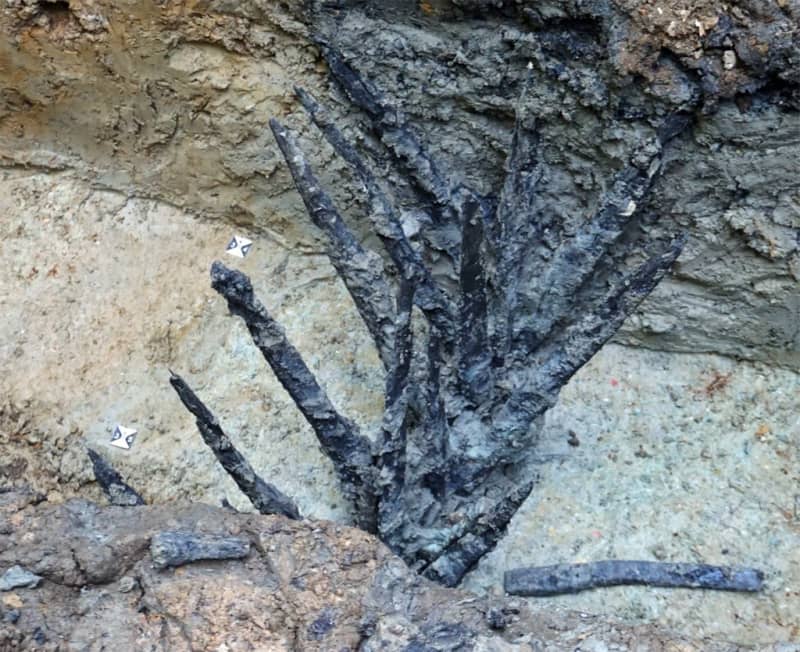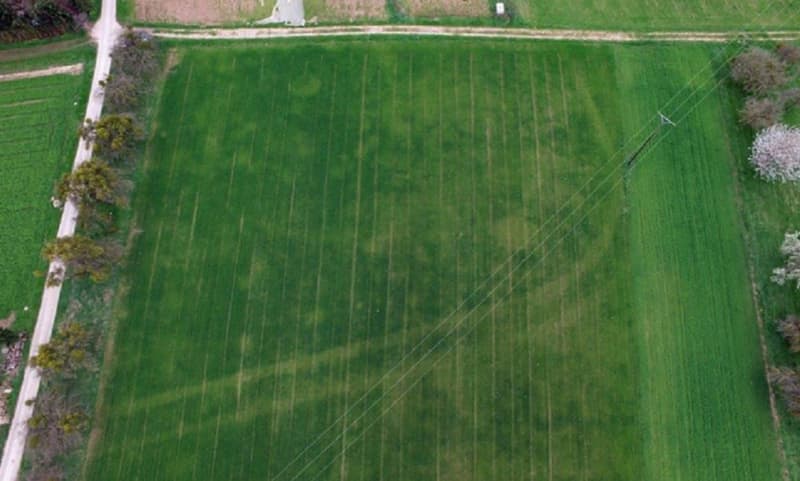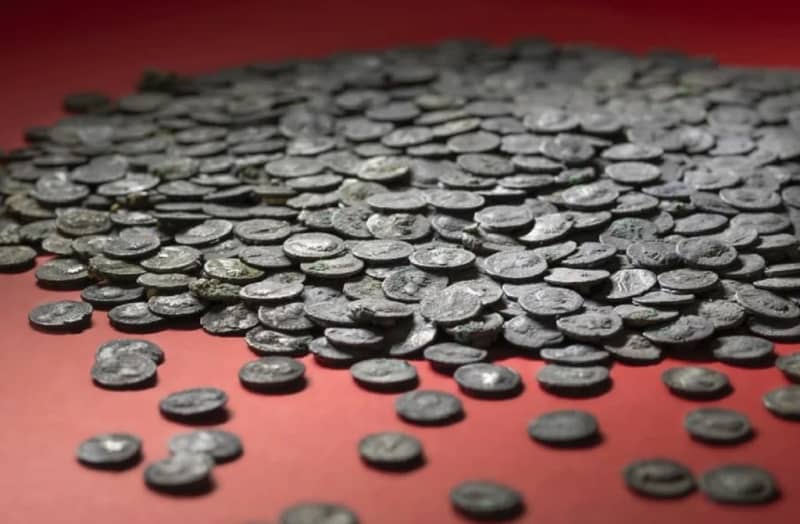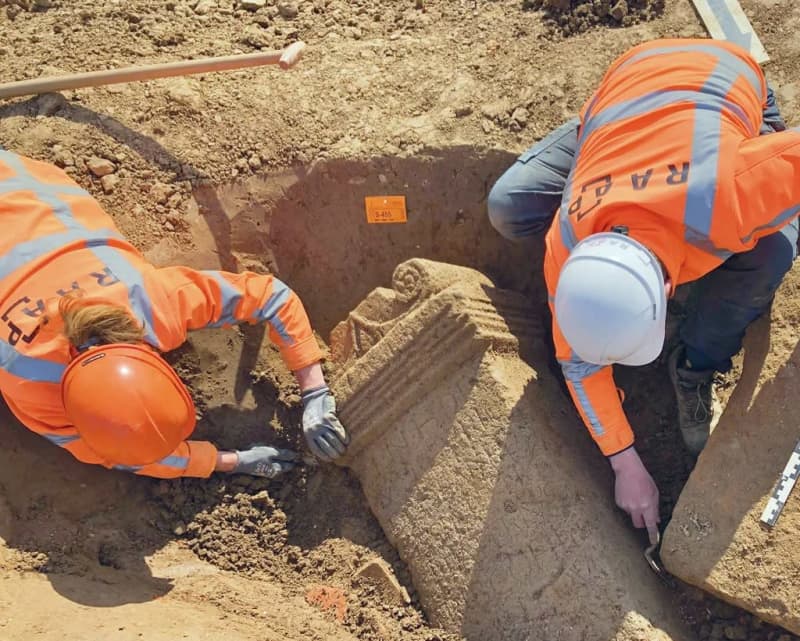
Another rare Roman find from the northern border tells how soldiers from the opposite side of the empire, even from Africa, appealed to their gods to survive in strange conditions 2,000 years ago.
Silver ore attracted the Romans in the first century to the western edge of present-day Germany, to the Ehrlich area near the town of Bad Ems. Two military camps were established on opposite slopes of the Emsbachjoki valley. In another, unique evidence of the way the Romans defended their camps has now been found.
The discovery of excavations by the Department of Archeology of the Goethe University in Frankfurt and the Museum Office of the State of Rhineland-Palatinate is, on the surface, just a bunch of sharpened wooden sticks. However, they are the first ever tangible proof of what awaited the enemies who tried to enter the Roman camps.
The remains preserved in the moist soil are wooden spikes that were attached to the central post in the shape of the letter V. The poles were driven into the bottom of the ditch surrounding the camp.
The enemy who fell into the ditch could feel the sharp line in their skins. Goethe University researchers compare it to today’s barbed wire fence.
Such structures are known from contemporary writings – even Julius Caesar mentions them – but as wood they were not suitable to last in the soil for two millennia and they have not been found anywhere else.

The tracks of the camps located on the opposite sides of the valley were found last decade, when a forester looking at the area from the upper slope saw color differences in the field. When the field was filmed with a drone, it looked as if a large tractor had been driving around the field.
In reality, the picture shows two parallel ditches that once surrounded a large Roman military camp. In ground radar sounding, it turned out to be almost eight hectares in extent. Around 40 wooden towers were located at the same time. Few Roman camps in the Rhineland-Palatinate are so large.
Archaeological excavations revealed that the camp was apparently never fully built. Only one storage building turned out to be permanently erected. According to the camp’s estimate, three thousand soldiers probably slept in tents, researchers say.
A group of archeology students found a second camp intended for only about 40 soldiers and a barbed wire fence at the bottom of the ditch a few kilometers away on the other side of the valley. The searchers were given a hint by the small signs of enrichment of silver ore found there at the end of the 19th century.
It was concluded that the enrichment was connected to the border line of the Roman Empire, Limes Romanus, which ran 800 meters away and was built in the 110th century. However, a coin was found next to the barbed wire fence, which had already been minted in 43, and the structure thought to be an oven was indeed a watchtower.
Fire marks indicate that both camps were burned down only a few years after they were set up. According to the archeologists’ hypothesis, there was no longer a need for them. They had been supposed to secure valuable silver from robbers, but no silver had been found.
The management of silver resources was the essential geopolitics of the time. The silver denarius was the most common currency of the Roman Empire and the backbone of the economy from the 100th century before the beginning of our era until the 200th century on this side of the era.
However, the silver content of the denarius dwindled to almost nothing along the way. From 95 to 98 percent, we ended up with two percent, such a thin silver lining on both sides of the copper core that it sizzled in the hands as soon as the coin came out of the mint.

The Romans got their silver – like other precious metals – primarily from Spain, but silver was mined for the needs of the central government in many other places throughout the great empire. At Ehrlich, however, it didn’t take long to succeed.
The soldiers, exhausted from digging, knew that similar toil was required of their comrades in other provinces. So they sent a letter to Claudius, begging him not to appoint his officials to preside over such gross vanity, but rather to reward them himself.
It was little known at the time that a silver vein ran very close to the tunnel thought to have been dug by Roman soldiers, from which 200 tons of silver would be mined centuries later.
The interest of enthusiasts revealed an archaeological treasure
Another recent and exceptional Roman discovery from the northern border of the kingdom is from the Dutch village of Herwen-Hemeling last summer. Signs of two or even more Roman temples were found there.
They had been built in the first century on a hill at the fork of the Rijn and Waal rivers, which had first been shoveled to increase the height. It was used by temple builders in case of floods and also so that the sanctuaries would rise closer to the sky.
The temples were in use until the 4th century, when the Romans’ hold on their northern territories was loosening.
Although several Roman sanctuaries are known from Holland, none have been along the Limes Romanus, and few have been preserved anywhere else in the north as well as the temples of Herwen-Hemeling.
Archeology enthusiasts made their first observations two years ago when they were investigating whether something interesting could be hidden in the area’s clay extraction site. Their artefact discoveries inspired the Dutch Museums Agency to order extensive excavations.

Among the colorfully painted mortar and roof tiles, a rare number of pieces of god statues made of limestone have been found in the ruins of the temples.
Traces of pits where soldiers burned sacrificial fires have also been left in the ground. The big well, to which the decorative stairs led, probably also had a religious meaning.
The temples of Herwen-Hemeling are also exceptional because they have been spared, despite the collapse of Roman rule. Temples were usually demolished and the material recycled or modified for other needs after the Romans left.
Archaeologists found dozens of small sacrificial altars in the ruins of the temples, the kind that have rarely been found in their original places on the northern edge of the Roman Empire.
The carvings contain the names of the gods as well as the officers who made the altars, military ranks and units. One of the engravings tells of a high-ranking officer who came all the way from Africa, the other of a northern Spanish cohort. Those who came to the north from different parts of the vast empire brought their own gods with them.
Promises made to the gods were confirmed at the altars. Offerings were used to thank and ask for protection in the unpredictable conditions at the extreme edge of the kingdom. Animal finds tell about the sacrifice of chickens, pigs, sheep and oxen.
Altars were especially dedicated to Mercury, Jupiter-Serapis and Hercules-Magusanus, who was a popular deity in the lower reaches of the Rhine in the first century and, according to etymologists, also called a half-Germanic Peru.
Jupiter-Serapis, on the other hand, was a Greek-Roman combination, and the meeting of cultures is also indicated by the dedication of altars to a cult that combined the Roman goddess of heaven and marriage, Juno, and the Celtic-Germanic mother goddess Matres.

Stamps on the roof tiles confirm the temples as being made by soldiers, and based on other finds, they also seem to have been used almost exclusively by them. There are a lot of memories specifically from military life: pieces of armor, parts of horse harnesses, spear points.
From the pieces of pottery, researchers have concluded that the soldiers did not use the same type of vessels as the Batavian, a Germanic tribe in the area, but that the vessels were Roman in style even though the capital was far away.
A 3D model based on laser scans is to be made of the temple area. The objects can already be viewed online on the website of the archeology company RAAP. RAAP, which was responsible for the investigations, has also made a video of them on its website.
*Birth of the Roman Empire*
*Destruction of the Roman Empire*
